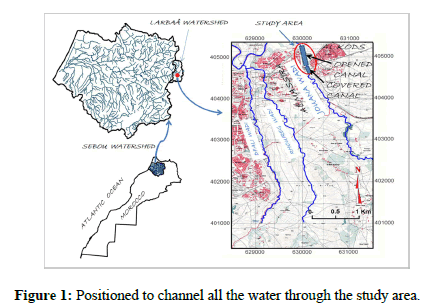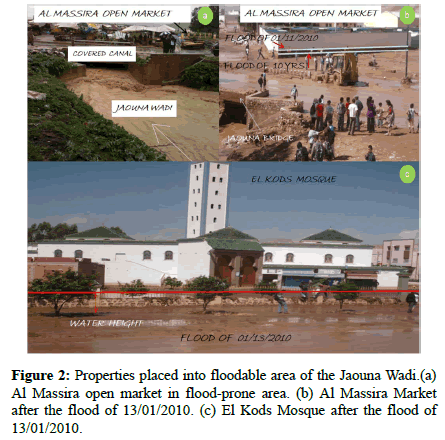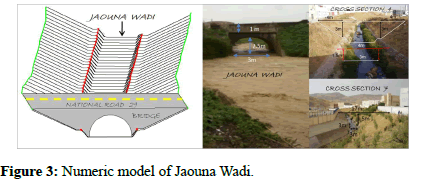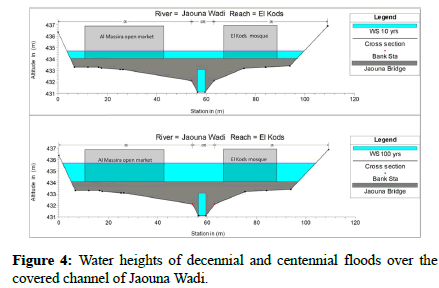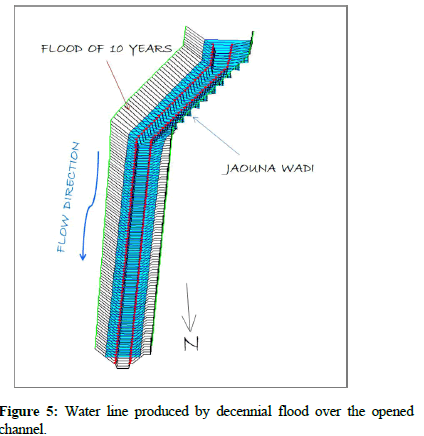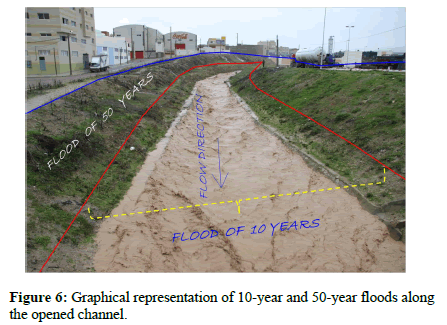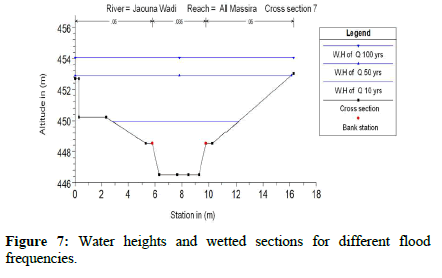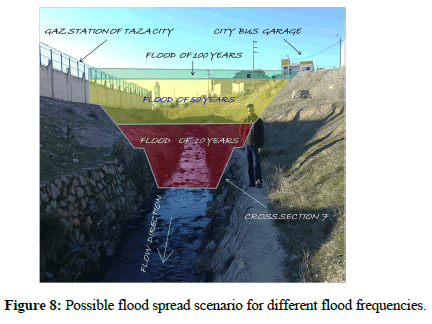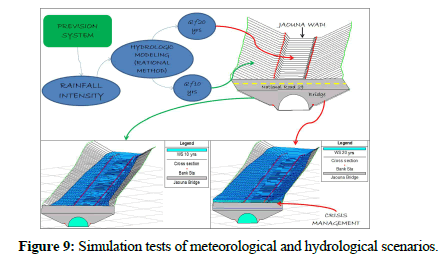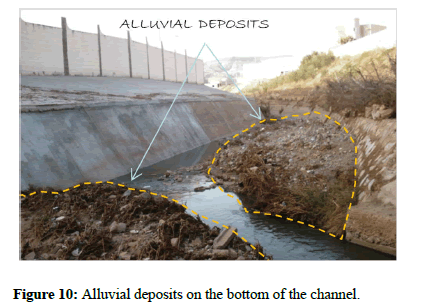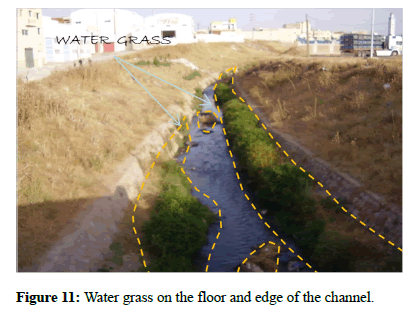Research Article, J Hydrogeol Hydrol Eng Vol: 13 Issue: 2
Numerical Model for Flood Hazard Forecasting in an Urban River of Taza City, Morocco
Badr Layan1*, Mahmoud Zemzami2 and Brahim Bougdira3
1Laboratory of Geodynamics and Natural Resources, Faculty of Sciences Dhar El Mahrez, USMBA, Fez, Morocco
2Department of Geology, Superior School of Education and Training, MFU, Ouajda, Morocco
3Laboratory of Space Recomposition and Sustainable Development, CDU, El Jadida, Morocco
*Corresponding Author: Badr Layan,
Laboratory of Geodynamics and natural
resources, Faculty of Sciences Dhar El Mahrez, USMBA, Fez, Morocco
E-mail: layan.floods@gmail.com
Received date: 03 March, 2024, Manuscript No. JHHE-24-128720;
Editor assigned date: 05 March, 2024, PreQC No. JHHE-24-128720 (PQ);
Reviewed date: 19 March, 2024, QC No. JHHE-24-128720;
Revised date: 26 March, 2024, Manuscript No. JHHE-24-128720 (R);
Published date: 03 April, 2024, DOI: 10.4172/2325-9647.1000301
Citation: Layan B, Zemzami M, Bougdira B (2024) Numeric Model for Flood Hazard Forecasting in an Urban River of Taza City, Morocco. J Hydrogeol Hydrol Eng 13:2.
Abstract
Forecasting flood hazards is essential for locating vulnerable places, measuring flood effects, anticipating possible damages, and investigating mitigation options. Attempting to anticipate flood dynamics at various return periods, this work employed the river simulation model over the highly populated section of the Jaouna Wadi (River) in Taza city. The model's inputs included future floods calculated utilizing a rational method, physical variables approximated using standardized tables (Manning coefficient), and other inputs directly measured in the field. The stability of the model demonstrated that its parameters had been precisely assessed. The outputs were compared to the observed floods during the calibration phase, and any necessary corrections were performed to guarantee that the model reproduced results within a reasonable range. Our findings revealed that the covered channel was insufficient for evacuating water during decadal floods. Aside from this section, the 10-year floods flowed through the opened channel without spilling over its banks. The 100-year floods ran over the channel's banks, spreading large amounts of water to inhabited zones and cultivated fields. These results were in accordance with recent floods and also supported evidence from previous observations, indicating the accuracy of the prediction of the Wadi’s behavior. The study signifies that the model is a powerful tool for detailed flood risk assessment, especially in limited areas.
Keywords
City of Taza; Jaouna Wadi; Forecasting flood hazard; River simulation model
Introduction
The flood hazard risk has significantly risen over the past two decades. This increase is strongly correlated to climate change and uncontrolled land use [1-7]. Morocco, like other countries in the world, suffers from flood events that frequently threaten human lives and properties. Indeed, many Moroccan cities have experienced exceptional flooding. Some floods reached catastrophic levels, claimed thousands of lives, and greatly affected the economy to the order of billions of Moroccan dirhams. Powerful floods from various Wadis intersecting the urban area have also impacted Taza City [8,9]. Jaouna Wadi is one of the region’s rivers that are continually generating threats to the residents living on the riverside. The floods in this particular river are permanently putting people and their property in a vulnerable position. They are an unstoppable force affecting the local population and impacting its regular activities, often leaving behind not only financial burdens but also emotional distress. According to ABHS in 2001, the flood of 2000 was the strongest and deadliest to have hit the city in more than a century. Eyewitnesses reported that the flood’s devastation was attributed to the combination of heavy rainfall and important urban developments in areas at high risk of flooding.
To forecast the flood hazard risk, a variety of models are able to predict the dynamics of infrequent overflowing events in order to avoid or reduce their impacts. The hydrodynamic approach is widely used in replicating rivers's behavior [8,10-19]. It is commonly considered an excellent tool to evaluate flood amplitude. This method has also proved computationally efficient, especially for 1D modeling, which is highly suitable for specific analyses.
This paper applies 1D hydrodynamic modeling to identify the dynamics of the Jaouna Wadi. It concentrates on simulating flow movements in the channeled sections (covered channel and opened channel) using the Hydrologic Engineering Center-River Analysis System (HEC-RAS). This is one of the most widely utilized models. Unlike other numerical models, HEC-RAS takes into account the presence of hydraulic structures [20,21]. Numerous authors of various nationalities have confirmed the model's effectiveness. The Federal Department of Transportation in the United States uses the model extensively [22]. Also, the hydraulic basin agencies in Morocco consider the model the most convenient method for flood estimation [23,24].
Thus, we use the numeric model to reproduce different fluvial interactions over the observed floods as well as the designed ones. Similarly, the model will demonstrate its ability to simulate flow at the hydraulic structures and evaluate their performance with various peak flows. This will allow us to introduce and investigate more specific research questions, such as how the model matches the Wadi’s behavior and how well it emulates flooding.
Study area
The Jaouna Wadi Watershed covers an area of 48.2 km, located within the Larbaa catchment. The Laazib watershed borders it to the north, the Moulouya Wadi tributaries to the south, the Bouljraf watershed to the east, and the Dfali and Rhouireg watersheds to the west. Cold winters and hot summers characterize the semi-arid climate in this area. The rainfall is often intense and of short duration, leading to frequent and severe floods. The study area encompasses the northeastern part of Taza City, particularly the Al Massira and El Kods neighborhoods. Along this area, the Jaouna Wadi intersects the most densely populated zone, bustling with activity. To facilitate the flow, the Wadi has been confined within a concrete channel. This hydraulic structure is covered upstream, while it remains open downstream. It was placed to make the entire water run through it (Figure 1). Unfortunately, over time, fluvial deposits and waste discharged by the local population have partially clogged the channeled section. In addition, the city hall has gained more land by occupying the space on the channel's ceiling. The slab cover of the channel has been used as a stage for a vibrant open market, catering to the nearby community's needs (Figure 2). This market represents a buzzing hub of economic activity, providing permanent jobs for a wide range of populations, which ultimately ensures stable incomes for them. On the contrary, this human action has often worsened flood events. Over the past two decades, eyewitness accounts have reported significant flooding in these neighborhoods.
Materials and Methods
To simulate the dynamics of the flood, we followed several interconnected stages, where each one led to the next. We started by building a numeric model of the specific portion of the simulation. Then, we determined the peak flows for different frequencies and eventually estimated the roughness coefficients for the channel and its floodplain.
Numeric model of the river
To represent the morphology of the Wadi, a digital model was developed. This involved various parameters, such as cross-sections and longitudinal profiles. These physical parameters played a crucial role in the functioning of the model. They provided valuable information on the floodplain topography as well as the channeled section geometry (Figure 3). To gather precise data, the profiles were measured in the field using GPS and a rolling meter. They were perpendicular to the flow and took into account the floodplain width. Additionally, great care was taken to draw the transversal sections from left to right. The spacing between two consecutive cross-sections was tighter to maintain the natural shape of the Wadi.
Peak flows at different frequencies
Assessing the flood dynamics on the alluvial plain requires careful consideration of the peak flow data. Employing the rational method, we determined these necessary hydrological parameters (Table 1). The floods at different return periods were inputted into the upper section of the channel and were considered valid throughout the entire simulated area. Although the flows’ values remain constant, the hydraulic model has the capability to adjust them in specific crosssections when certain variables affect the fluvial hydraulic interactions.
| Q in m3/s for different frequencies | |||
|---|---|---|---|
| Q of 10 yrs | Q of 20 yrs | Q of 50 yrs | Q of 100 yrs |
| 42 | 70 | 168 | 241 |
Table 1: Flow rates (Q m3/s) employed in the numeric model.
Coefficients of roughness
In current research, the roughness coefficient has not been well considered. It has only been a topic of a few studies that have deeply focused on understanding the spatial-temporal distribution of this variable. Also, many hydraulic engineers (White, Colebrook, Bazin, and Strickler) have attempted to establish a deterministic formula for this coefficient based on the roughness of the water-floor interface. None of these formulas have been completely satisfactory [11,14]. In fact, the roughness coefficient is changeable with land characteristics. It is highly complex and encompasses multiple concepts that are not fully defined. Overall, the variable takes into account various factors (vegetation density, irregularity of the riverbed, width of the surface water, and differences in soil composition). All these parameters influence the resistance to flow differently [25].
We selected the roughness coefficients using the field evidence and also referred to the standard tables provided by Chow [26]. Therefore, the roughness coefficients were determined based on the specific characteristics of the riverbeds and banks. The bottom of the Jaouna Wadi is characterized by a predominance of fine gravel, which makes the roughness coefficients vary between 0.035 and 0.05. We believe that values between 0.03 and 0.05 accurately represent the possible range of coefficients applicable to the Taza region. According to the hydraulic basin agencies, values ranging from 0.04 to 0.05 may be more appropriate for this purpose.
Results
Calibrating a model can be considered the most complex stage of the hydraulic simulation process. This involves multiple examinations to achieve results aligned with observations. We calibrated our model using the flood event that occurred on 09/19/2008. We conducted sensitivity tests by making slight adjustments to the model's features. This allowed us to represent this recorded flood with its physical characteristics. The outputs confirmed the stability of the model, indicating its capability to reproduce observed and future floods.
In the covered channel, the results show that the bridge of the channel is undersized to handle the floods of different periods ranging from 10 years to 100 years. This cross-structure blocks the flow and retains running water in the upstream part of it. Ultimately, it contributes to a waterlogging process, leading to spills of water over the road. Such a scenario was observed when a flood occurred on 1/13/2010, which confirmed that the channel was too small to evacuate the overflowing water. This factor reinforced inundation impacts upstream and downstream of the channel. Furthermore, the centennial flow rate makes the water heights reach the coast at 435.73 NGM, causing an overflow of 1.7 meters in the open market and El Kods Mosque area (Figure 4).
On the other hand, the decennial flood is successfully contained within the opened channel. The flow maintains a consistent wetted area and stable heights along its path (Figures 5 and 6). Unlike the covered section, the decadal flow passes freely without overflowing the thalweg’s banks or the population residing on the alluvial fans. The flow rate of a 50-year flood is four times greater than that of the decennial and is strong enough to flow the river’s banks, generate vast water spreads, and eventually impact urbanized areas as well as cultivated fields. The water line surpasses the height of the wall surrounding the city gas station, generating water flowing into it. Closely related, the centennial flood shows a phase of major flooding. This flow rate causes water to run over the channeled section and severely affect inhabited zones on the floodplain (Figures 7 and 8). The flood problems remain catastrophic in this part of the city, and the techniques being applied are still far from being able to lower the risk and protect the public.
Discussion
The results reflect those recorded by eyewitness reports and are also in accordance with our earlier field observations (Figures 2b and 2c). The floods experienced and the simulated version are strongly similar. This information supports the model's ability to match natural river flows. It demonstrates that it is possible to mimic potential flood dynamics. This highlights the model's effectiveness in reproducing and predicting upcoming events. The model has a powerful capability to detect flood-prone locations, even in areas densely occupied by human activities. This makes it, compared to other methods, an efficient tool for simulating urban rivers. In parallel, the results provide valuable information for decision-makers and urban planners. They may help determine concrete measures to properly resize the Wadi’s channel for possible floods. Based on these results, immediate action is needed to relocate the open market to a safer location. With an urgent intervention, we will be able to avoid the current flood problems.
Identically, this model has evolved into an essential instrument for managing overflow instances and making judgments in real flood events. In our particular case, the model attempted to create a shortterm flood forecasting system that could precisely identify actual floods and predict where they would most likely end up in an operational setting. Although the system has not been entirely completed yet, the simulations and testing of hydrological scenarios have proved its possibilities (Figure 9).
Despite these capabilities, the model, like other simulation methods, has some drawbacks. We ran into an important problem that flood designers frequently struggle with: Model calibration. Regardless of the presence of numerous studies on this topic, the literature remains a little debated and insufficiently explained. Calibrating the model by matching observed floods with simulated ones may appear to be a reasonable and impressive technique. But the calibration process entails modifying values without understanding exactly which specific variables need to be adjusted. The physical factors that interacted within the hydraulic system to cause the recorded flood are often unknown to us. Consequently, there is a possibility to overestimate or underestimate these variables. Further research should concentrate on the calibration features where the model's performance is unclear and work towards improving its precision and reliability.
Another challenge we encountered while using HEC-RAS was the representation of blocked obstructions across the channel. These obstructions include deposited materials and water grass, which significantly affect the channel's roughness (Figures 10 and 11). Fortunately, the model permits inserting the geometry of these elements, but the hydraulic computation is limited to herbed surfaces. This impacts the roughness of the bottom-water interface, which has a direct influence on the waves’ behavior. Taking into account these variables, the model can achieve more detailed outputs.
Conclusion
The river simulation model employed in this study has demonstrated its effectiveness in forecasting flood hazard risks in the highly populated section of Taza City. By utilizing inputs derived from potential flood and physical variables, the model accurately predicted the behavior of the Jaouna Wadi. The results provided valuable insights for mitigation planning and response strategies. The identified shortcomings in certain cross-structures for evacuating water under different flood frequencies emphasize the importance of proactive infrastructure upgrades to protect vulnerable locations. Overall, this research contributes to the ongoing efforts to better understand floods and find effective measures to minimize their impact. This consequently improves the resilience of communities and infrastructure in flood-prone areas.
References
- Akdim B, Laaouane M, Taous A (2003) Risques hydrologiques dans la region de Taza, genese, consequences et problemes d amenagement. Geomagreb 14: 47-60.
- Layan B (2014) Determination of project floods, hydraulic modeling and flood risk management in the Wadi Larbaa watershed. Case of the city of Taza (Morocco). These De Doctorat, Universite Sidi Mohamed Ben Abdallah Fes.
- Schilling K, Gassman P, Kling C, Campbell T, Jha M, et al. (2014) The potential for agricultural land use change to reduce flood risk in a large watershed. Hydrol Process 20(8): 3314-3325.
- Winsemius H, Aerts J, Beek VL, Bierkens MFP, Bouwman A, et al. (2016) Global drivers of future River flood risk. Nature Clim Change 6: 381-385.
- Zope P, Eldho T, Jothiprakash V (2016) Impacts of land useland cover change and urbanization on flooding: A case study of Oshiwara River Basin in Mumbai, India. Catena 145: 142-154.
- Bloschl G, Hall J, Parajka J, Perdigao R, Merz B, et al. (2017) Changing climate shifts timing of European floods. Science 357(6351): 588-590.
- Pavesi L, Angelo C, Volpi E, Fiori A (2022) RESCUE: A geomorphology-based, hydrologic-hydraulic model for large-scale inundation mapping. J Flood Risk Manag 15 (4): e12841.
- Zemzami M, Benaabidate L, Layan B, Dridri A (2012) Design flood estimation in ungauged catchments and statistical characterization using principal components analysis: Application of Gradex method in Upper Moulouya. Hydrol. Process 27(2): 186-195.
- Layan B, Dridri A, Benaabidate L, Zemzami M (2013) Determination of design floods by aspects of peak flow and flood hydrograph in watershed of Larbaa River, Taza (Morocco). J Hydrogeol Hydrol Eng 2(1): 1-6.
- Schaake JC, Geyer JC, Knapp JW (1967) Experimental examination of the rational method. J Hydraul Div 353-363.
- Horritt MS, Bates PD (2001) Predicting floodplain inundation: Raster-based modelling versus the finite-element approach. Hydrol. Process 15 (5): 825-842.
- Roux H (2004) Estimation of parameters in river hydraulics, based on characteristic data from aerial imagery, INP Toulouse, IMFT.
- Kreis N (2004) Flood modeling of mid-mountain rivers for integrated flood risk management: Application to the Thur valley (Haut-Rhin). Doctoral dissertation, National School of Rural Engineering, water and forests.
- Werner MG (2005) Identifiability of distributed floodplain roughness values in flood extent estimation. Journal of Hydrology 314 (1-4): 139-157.
- Vidal JP (2005) Assistance in calibrating digital models in river hydraulics-contributions of artificial intelligence. Contributions of artificial intelligence.
- Sarah M, Francisco O (2007) Floodplain mapping and hydraulic analysis with HEC-GeoRAS 4.1.1 and ArcGIS 9. Texas A&M University 1-42.
- Hunegnaw D, Arega M (2021) Mapping flood inundation areas using GIS and HEC-RAS model at fetam river, upper abbay basin, Ethiopia. Sci Afr 12: e00834.
- Habtamu T, Megersa OD (2021) Application of ANN and HEC-RAS model for flood inundation mapping in lower Baro Akobo River Basin, Ethiopia. J Hydrol Reg Stud 36: 100855.
- Zohra A, Nouibat B (2023) Hydrological-hydraulic modeling of floodplain inundation: A case study in Bou Saada Wadi-Subbasin Algeria. Handbook of hydroinformatics 3: 219-232.
- United States Army corps of Engineers, USACE (2009) Hydrologic Engineering Center geo River Analysis System (HECgeoRAS). GIS tools for support of HER-RAS. Using ArcGis. User’s Manual. Approved for public Release. Distribution Unlimited.
- United States Army corps of Engineers, USACE (2010) Hydrologic Engineering Center-River Analysis System (HEC-RAS) user’s manual. Approved for public Release. Distribution Unlimited.
- Texas Department of Transportation (2019) Hydraulic Design Manual, Design Division.
- Agence du Basin Hydraulique de Sebou, ABHS (2001) Etude de delimitation du niveau des plus hautes eaux de l’Oued Larbaa, ville de Taza. 4P+annexes.
- Agence du Basin Hydraulique de Sebou, ABHS (2005) EPVBCI. Etude de la protection de la ville de Boulemane contre les inondations. 28P+annexes.
- Aizhong Y, Zheng Z, Jinjun Y, Feng M, Qingyun D (2018) Dynamic Manning’s roughness coefficients for hydrological modeling in basins. Hydrol Res 49 (5): 1379-1395.
- Chow VT (1959) Open Channel Hydraulics, McGraw-Hill Book Company, Inc. New York.
 Spanish
Spanish  Chinese
Chinese  Russian
Russian  German
German  French
French  Japanese
Japanese  Portuguese
Portuguese  Hindi
Hindi 